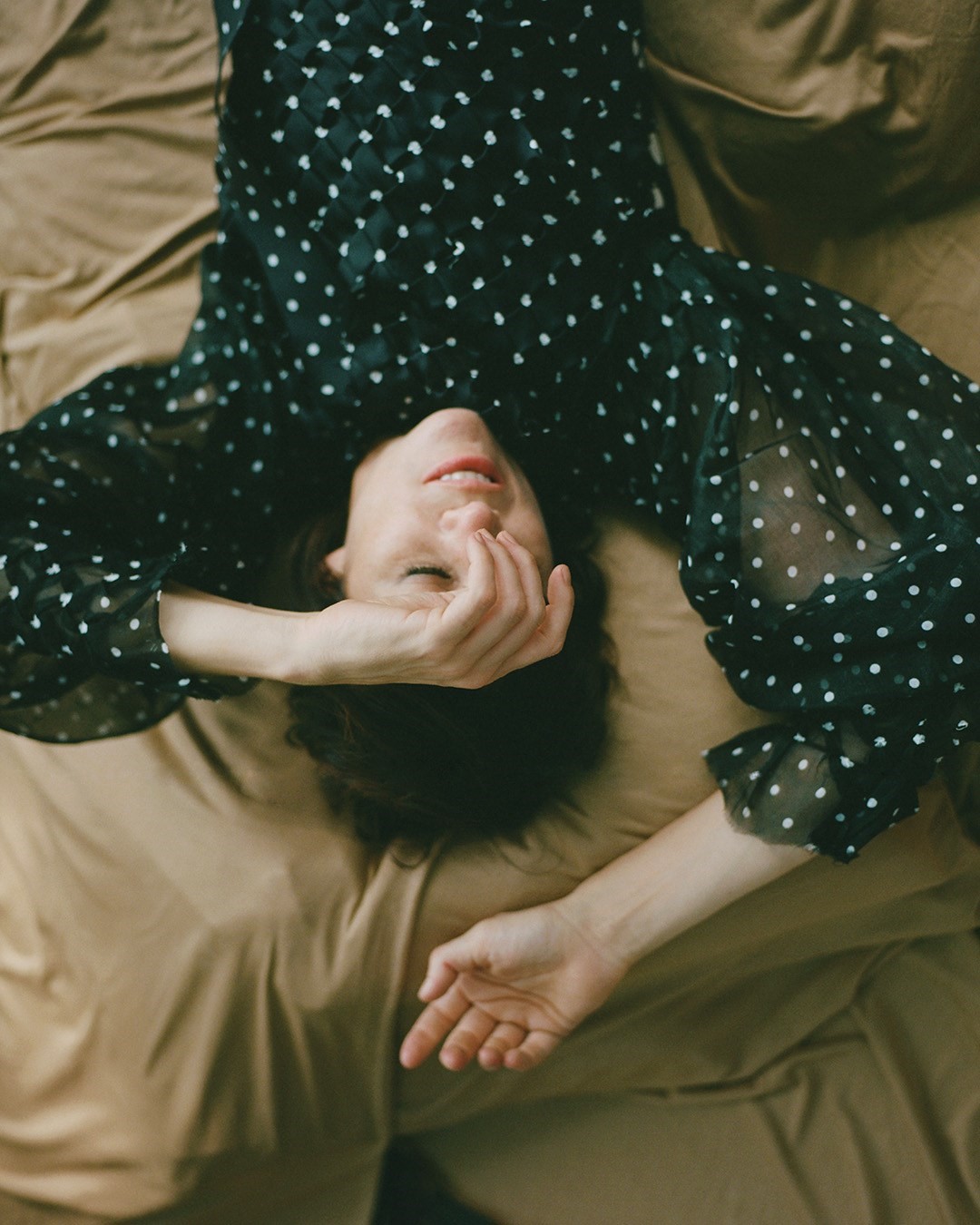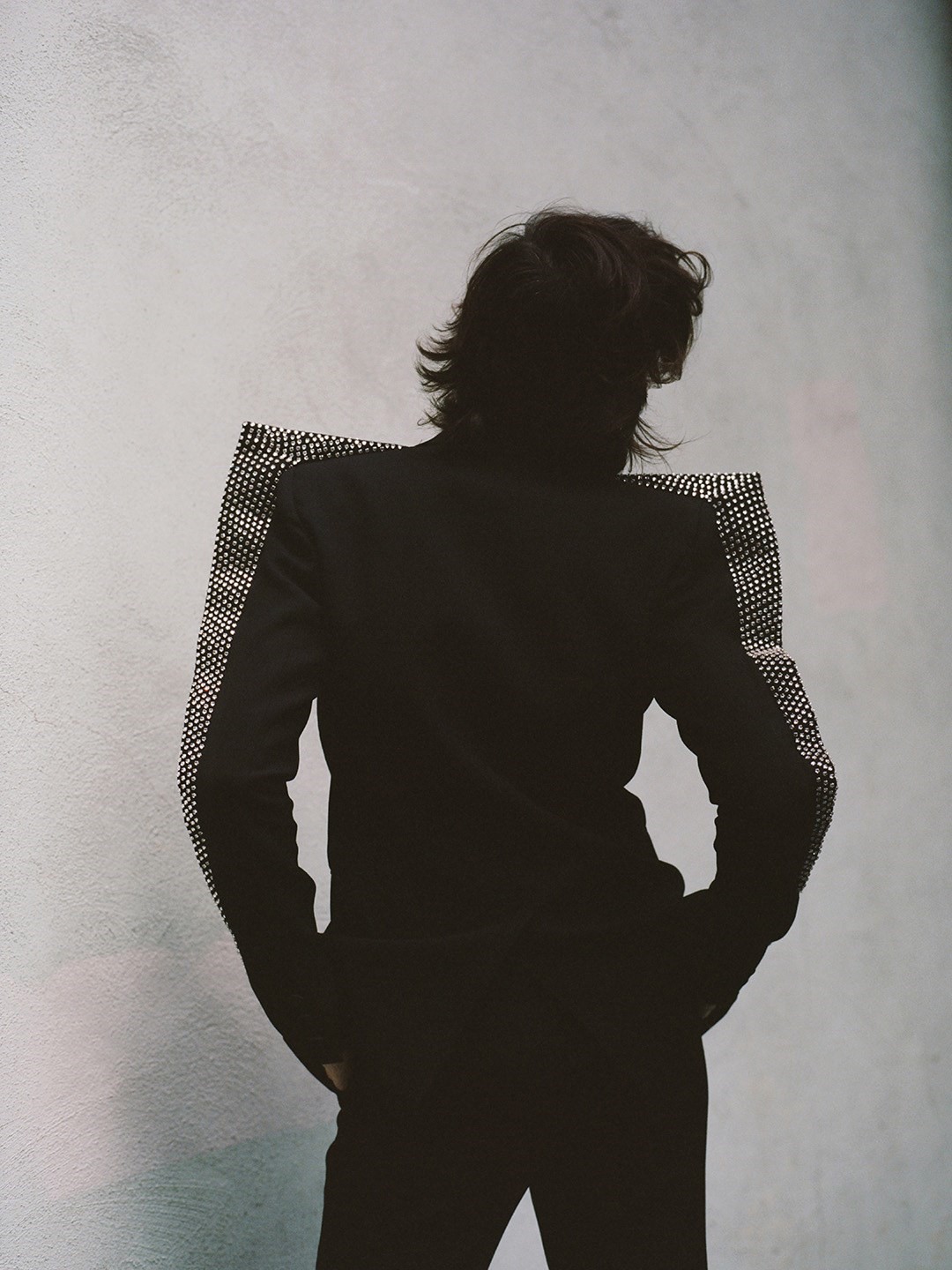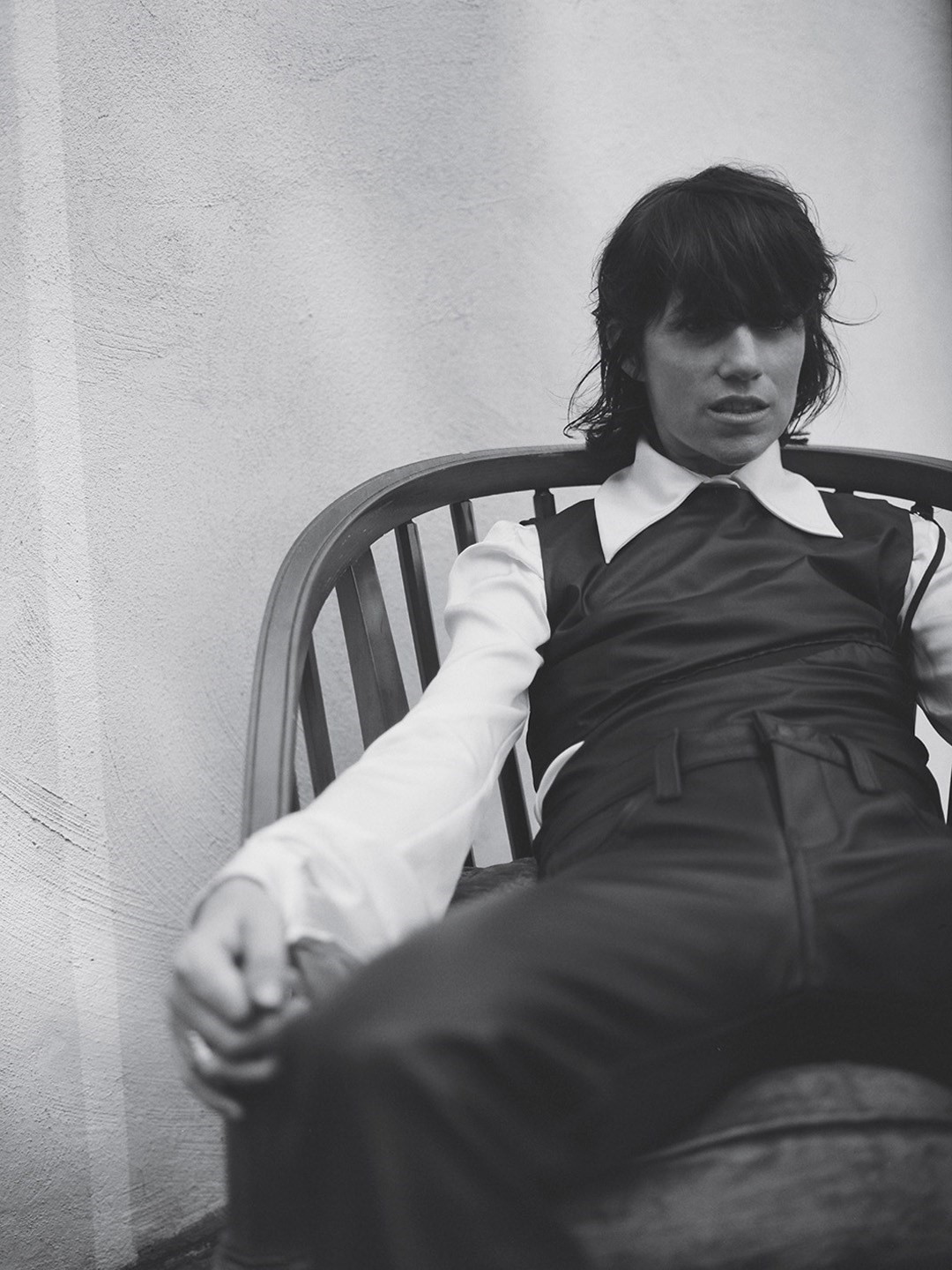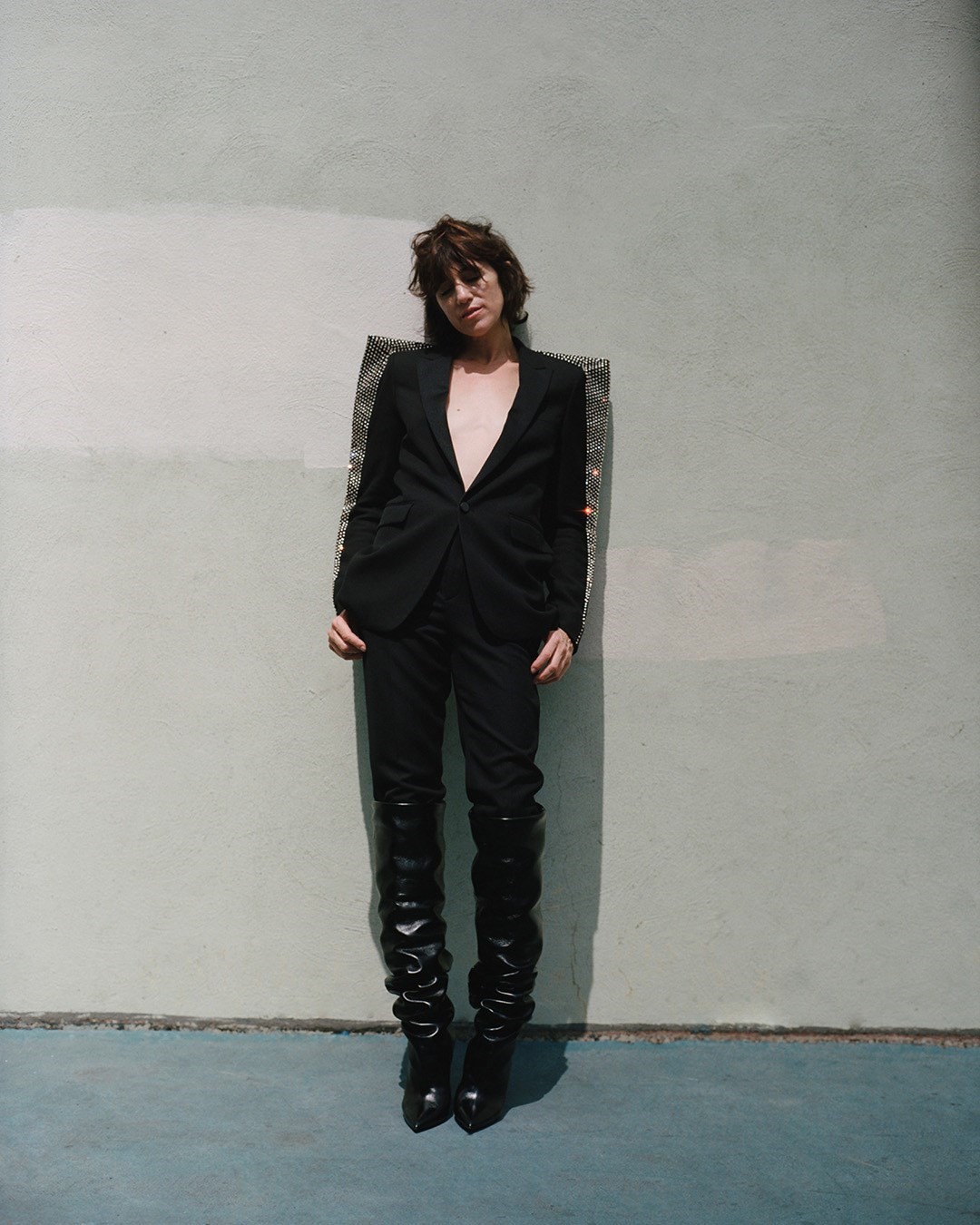Taken from the autumn/winter issue of Dazed. You can buy a copy of our latest issue here.
Dazed will be publishing a series of articles with Charlotte Gainsbourg throughout the day – head here to read more.
Charlotte Gainsbourg has a video message on her phone from Robert De Niro, telling her she is welcome at The Greenwich, the beautiful hotel he owns in New York City, any time she likes. It’s a Friday afternoon and we’re sitting at his favourite table in the hotel’s garden, where he often works. It’s a spot that’s discreetly commanding – the best in the house. On the table are coasters featuring artwork by De Niro’s father, an abstract expressionist painter, in which a woman is seated in a green chair. “I don’t know if it’s his mother, but I’d like to see who she is because I feel that I’m very close to this,” she exclaims, with a laugh.
De Niro’s gesture is emblematic of the regard people have for Gainsbourg. Kind and rare, coupled with an aura that draws you in, she is preternaturally gentle – but with the casual audacity to wear a black bra under a gossamer-fine white t-shirt. Which is exactly what she’s wearing today.
Gainsbourg moved to New York several years ago, having lived in Paris her whole life. Her last name, of course, goes together with Paris like coffee and cigarettes. Her father, the late Serge Gainsbourg, is France’s most celebrated and charismatic singer-songwriter, a master of nuanced wordplay fluent in the art of controversy. Whereas actress and musician Charlotte, who has been famous since she was a child, is predominantly lauded for her work on screen. She has brought a disarming realism to some of the most uncompromising European cinema of the past 30 years, working with auteurs such as Michel Gondry and her best-known collaborator, Lars von Trier – who pushed Gainsbourg to new extremes in Antichrist and Nymphomaniac parts I and II. But the loss of the singer and actor’s older half-sister Kate in 2013 was a tragic accident that changed everything. She needed space and a new context.
“I wanted to escape from Paris,” says Gainsbourg, who has been with her partner, the actor and director Yvan Attal, since she was 19. “When I came here I (spent all my time) with my family. I started writing, I started doing my own videos, taking pictures. It was very... I don’t know if it’s New York, or the fact that I wasn’t at home. And then I could only write about (Kate), it was painfully obvious.”
Gainsbourg’s outpouring has resulted in a new album, Rest, due in November. Not only is it her most personal to date, it’s probably the most exposed collection of songs you’ll hear all year. It’s also her first to be sung predominantly in French since Charlotte for Ever, her 1986 debut written by her father. It’s a step Gainsbourg admits she was nervous to take because of her dad, whose own lyrical talents earned him comparisons with Baudelaire and Apollinaire in his lifetime. “I had such a barrier because of my father – just looking up to him so obviously,” she says. “For years I thought I’d never dare to write in French, but this time I didn’t care. I don’t have his genius, but for me, that was the only thing that mattered – my own judgment.”
For the record’s production, Gainsbourg found an unlikely collaborator in Sebastian Akchoté, AKA Ed Banger dynamo SebastiAn. “I was looking for this electronic sound because it was such a contradiction,” she explains. “Having something that was quite violent – and even grandiose – with this tiny voice. I knew that I wanted to work with SebastiAn. That’s what attracted me.”

Still, Rest is a long way from the thunderous crash of SebastiAn’s own music. Think of Gainsbourg as a kind of horse-whisperer in this scenario, channelling the problem child’s unruly impulse. It’s a pairing that clicks into high gear on the song Sir Paul McCartney wrote especially for her, called “Songbird in a Cage” – where Britain’s biggest musical export meets France’s most revered, mixed by a one-man electro Motörhead. When your signature portrait is by Jean-Baptiste Mondino, as SebastiAn’s is, you can do exactly as you like. Charlotte’s, FYI, is by Collier Schorr. They’re a pair well matched.
“He’s such a myth,” Gainsbourg says of McCartney, who joins Daft Punk’s Guy-Manuel de Homem-Christo and Connan Mockasin as a collaborator on the album, recorded at Jimi Hendrix’s Electric Lady in New York. “Every encounter I had with him – lunch, the recording here and a phone call – each time it was completely surreal.”
Gainsbourg has a happy knack for bringing out the best in her collaborators. The singer’s 2009 album, IRM, produced by Beck, was defined by its tramping percussion, clipped drums and the shades of odd synonymous with everyone’s favourite slacker-pop genius. Her prior record, 5:55, made with Air, Jarvis Cocker and Neil Hannon, was produced by (Radiohead regular) Nigel Godrich and sonically – likely through its collaborators, who are all fans – felt like a memory of her dad. Gainsbourg was headstrong about singing almost exclusively in English, a songbird determined to leave her cage. Released in 2006, it was her first record in 20 years.
“That’s why I made a link between my father and Lars (Von Trier) – they have nothing in common, but thanks to them I was able to go to... not scandalous places, but places I wouldn’t have dared to go on my own” – Charlotte Gainsbourg
Despite its recording in New York, Rest is the singer at her most PARIS (writ large and gorgeous). Like a chandelier made of strobe lights, it encapsulates elements of the classical but within the city’s recent creative cycle. While not the statement of a Grande Dame like La Deneuve or the late, great Jeanne Moreau, the record is a fine reminder that, in France, respect comes with age. Because, unlike in most other places, idols are allowed to mature in Gainsbourg’s home country. La vie est belle? Not always: life colours the spirit differently the more it is tested. When you are tender, you feel more compelled than ever to tell the truth – and Rest is nothing if not truthful, with Gainsbourg singing openly about her father’s death (“Lying With You”), the passing of her sister (“Kate”), her crippling shyness (“I’m a Lie”), childhood fears (“Les Crocodiles”) and the passage of time (“Ring-A-Ring O’ Roses”).
It’s hard not to be moved by “Kate”, sung in Gainsbourg’s mother tongue. Visceral and soaring, the song is like a heart exploding, both celebratory and racked by grief. When I first heard it, it blindsided me, leaving a profound cloak of melancholy afterwards. It’s the third song on the album and, having listened to the record over and over, I still have to brace myself as the track starts to approach.
“I realise I did say things that are very intimate,” says Gainsbourg. “So, yeah, now I get surprises (listening back). There was something very spontaneous about the writing – I didn’t want to look too deeply into whatever came out.” For her, there is always an element of discomfort with things that are of merit. “I think acting has helped me understand this. With Lars von Trier, I was able to do three films (Antichrist, Melancholia and Nymphomaniac) that were all different. I got to understand his way of working. I think he helped me understand that being on the edge is what I’m aiming for. I like being comfortable, but it’s just not a creative spot. I like the awkwardness. It can feel like torture a little bit, but I’ve understood that I enjoy being tortured that way. To be directed, under the hands of someone I trust, to be pushed.

“It’s only with other people that I authorise myself to go places. That’s why I made a link between my father and Lars – they have nothing in common, but thanks to them I was able to go to... not scandalous places, but places I wouldn’t have dared to go on my own.”
Gainsbourg is good at resisting expectation. She wove the tangible out of thin air in Gondry’s surreal romance The Science of Sleep (2006), a cinematic adventure like no other. And in Von Trier’s Nymphomaniac (2013), where she stars as sex-fixated Joe, she threw herself into humiliatingly intimate scenes without complaint, knowing that they were crucial to the integrity of the script. She even prefers the full, five-and-a-half hour director’s cut – because that’s the director’s pure vision. Antichrist (2009), the other Lars movie she leads in, is arguably more distressing due to its traumatic premise. Last year, Gainsbourg surprised us by starring with Liam Hemsworth and Jeff Goldblum in the shiny blockbuster Independence Day: Resurgence. “I’m always keen to try,” she quips of her part in the movie. “Whenever it’s an American film – and not an independent film – it seems very far away. I’m happy to have the experience, but I don’t know where it takes me really.”
For her latest celluloid foray, Gainsbourg teamed up with Let the Right One In director Tomas Alfredson – “I love his cinema” – for wintry thriller The Snowman. Starring Rebecca Ferguson, Michael Fassbender, Chloë Sevigny and Val Kilmer, the film features a soundtrack by Radiohead’s Jonny Greenwood and has nothing to do with walking in the air or Christmas Eve ritual. Instead, it’s an unsettling affair concerning the disappearance of a woman whose pink scarf is found wrapped around a portentous-looking snowman. Her body has been found but the head is missing, sparking fears that a serial killer is on the loose. The definition of harrowing, it hits cinemas before Halloween – but is far more brutal and psychological than anything themed around fright night.

After that comes a French-language movie, La Promesse de l’Aube, a new screen adaptation of Romain Gary’s autobiographical novel that will be released before the end of the year. “I was able to transform myself and become an old woman,” she says of her role as Nina Kacew, the Russian-born mother of one of France’s most celebrated authors. “Only the French would trust me with this kind of role. It’s important to me, exploring different countries. At one point I was doing a lot of Italian films and I felt so attracted to... I don’t know, those kind of personalities. With Lars it’s the same. It feels very singular.
“I think when you’re not 25 and you’re not American or English, it’s hard to find room. In France, people have known me since I was 12. I already exist. But here (in America), it’s like I would have to push... In French we have an expression, ‘pushing elbows’. I don’t want to do that. I’m old enough not to care that much. I’m very happy when things happen, I just don’t want to force them.”
One thing you notice is that never, at any point, does Gainsbourg refer to herself as an artist. She is more intuitive than that. “For me, (calling myself ) an artist is pretentious,” she says. “I feel that I’ve tried to be an actress, I’ve tried to be a singer, I’ve tried to write lyrics, and I will hopefully do more stuff, but being an artist is really having something to say. I do stuff for myself. I’m compelled to do things, but it’s not to share them with the world or make people better. I don’t have this vocation. That’s why I’ve always felt uncomfortable saying I’m an actress or a singer. I was lucky enough to have the parents I had – thanks to them, I took a step into music and then into the movie business. But I don’t know what I would have done without them. So it’s a bit tricky to assume things for myself and to know what I’m worth. But that’s OK. Today, I like the fact that I don’t know who I am. When I wrote ‘I’m a Lie’ – that song about my awkwardness and not feeling very comfortable in any place – that’s something I can talk about easily, very easily.”
“People will think it’s disgusting, but I love wearing a t-shirt at night and then wearing it in the day. That’s what I did (today). I think I like skin, not clothes” – Charlotte Gainsbourg
Born in London in 1971 to English model and musician Jane Birkin, Gainsbourg’s voice has all the delicate lilt of her mother’s, because that’s who she learned the language from. So it’s strange when the singer and actor confesses she isn’t confident with speaking in English. It’s only when she switches to French, racing with pure flair and liquidity, that you believe her. (“In French I know if it sounds posh, or if there’s humour inside,” she quips). She is the middle sister, with model and musician Lou Doillon – whose father is French director Jacques Doillon – youngest and the late photographer Kate Barry, whose father was the English composer John Barry, the elder. (She also has a younger brother, Lucien ‘Lulu’ Gainsbourg, from her father’s relationship with musician and model Bambou.)
Gainsbourg has been able to indulge her innate Parisienne as the face of Saint Laurent for AW17, enjoying a black sablé minidress with plunging neckline and thigh-high boots covered entirely in crystal. The shoulders are square, because that is important at YSL. As Pierre Bergé, Yves Saint Laurent’s partner in business and life, said: “Chanel liberated women, but Yves Saint Laurent gave them power.” Power starts with a strong shoulder – which intimidates weak men.
“I met (YSL creative director) Anthony Vaccarello when he was just Anthony and I loved what he did,” says Gainsbourg. “When he became designer for Saint Laurent, I followed. I’m not big into fashion, I just like having friendships with people. I’m still very, very close friends with Nicolas (Ghesquière) – he’s someone that I admire and I don’t want to look elsewhere. With Anthony, it was a bit of the same story.” Gainsbourg’s relationship with YSL began in the early 90s, when she was 19 years old and Mr Saint Laurent was still at the helm. “It was the first house I went to, for events like the César (awards) where I needed to get a dress,” she explains. “My mother said, ‘Go to Saint Laurent’ – as if it was the only house that existed. The dresses I was able to borrow were incredible. That was my first experience with fashion – not fashion, but haute couture. For events it was always Saint Laurent. And then I met Nicolas Ghesquière, and it became Balenciaga. My vows were to him.”

“I love being a monomaniac,” Gainsbourg continues, analysing her relationship with fashion. “You know, to only see one person, one style. I don’t want to have to ask myself questions about what I want to wear, what I want to look like. I have to establish it and then not think about it. People will think it’s disgusting, but I love wearing a t-shirt at night and then wearing it in the day. That’s what I did (today). I think I like skin, not clothes.”
And speaking of YSL icons, Gainsbourg’s first cinematic role was playing screen legend Catherine Deneuve’s daughter back in 1984, in Paroles et Musique. The film was significant for giving Charlotte a creative expression of her own, a chance to carve her niche away from the weight of her surname. From a distance, Deneuve had her best interests at heart.
“My mother came across Catherine in the street and said, ‘My daughter is about to do (Charlotte’s notorious duet with her dad) “Lemon Incest”’ – I think she was worried,” says Gainsbourg. “There was this film happening where they were looking for a young girl my age and Catherine said, ‘If she’s doing this thing with her father, she should have something of her own.’ And she pushed. I think my mother would have pushed, too, but it’s great to know that (Deneuve helped) my mother feel confident that I needed my own world. It’s very true – for years, cinema was just my business. My parents had nothing to do with it.”
“Today, I can see how therapeutic it was,” she adds, reflecting on her need to be recognised in her own right. “I needed to be looked at. It was a time where I had to get away from my own family and just get the focus on me – it’s weird to say that, but I was known as the daughter of my parents. I was able to do things that I could be proud of – it meant a lot.”

Gainsbourg also reveals she is keen to try directing, and has recently begun creating her own music videos. “I directed my first video for (album title track) ‘Rest’,” she explains. “I asked Lars von Trier if he would do a music video and he said, ‘I don’t have the time, I’m on to my (next) film, but this is what you should do.’ He talked me through the dogma that I needed to do for this track (Von Trier co-authored the Dogme 95 manifesto for filmmakers in the 90s). I did exactly what he said and that was my first music video. The second was ‘Ring-A-Ring O’ Roses’ – I wanted to film my son. He’s 20. It was, for me, so powerful to be able to get behind the camera, to look at him and realise what emotions I was feeling. I loved it so much.”
Collaboration has meant a lot to Gainsbourg over her career. Through her work in music and film, she has made it part of her vocabulary and ethos, the push-pull of shaping something together. But to hear her talk, at the age of 46, of firsts in her career – from writing lyrics in French to directing – is to see a new emancipation shining out of her. She’s always been of a mind to do exactly what she wants, but now, more than ever, she’s doing it.
Rest is out November 17 via Because Music
Hair Shingo Shibata at The Wall Group using Mr. Smith, make-up Jen Myles at Streeters, prop stylist Nicholas des Jardins at Streeters, photography assistant Aaron Thomas, styling assistant Mackenzie Thiry, make-up assistant Michaela Bosch, production Art + Commerce







